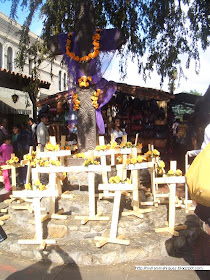Three beautiful girls in typical Mexican skirts celebrating the Day of the Dead. Picture by Myriam Mahiques
Rites of intensification mark crisis in a social group. The crisis could be a plague, war, a severe lack of rain, etc., and mass ceremonies are performed to mitigate the danger. These rites are carried out by a group of people and the effect is to unite people in a common effort in such a way that fear and confusion yield to collective action and a certain degree of optimism until the natural balance is restored. The performance of rites of intensification are not limited to times of crisis. In regions when seasons differ and human activities change accordingly, annual ceremonies develop; this is common among horticultural and agricultural societies. “Participation in such ceremonies cultivates the habit of reliance on supernatural forces through ritual activity, which can be activated in other stressful circumstances”.(Grant, Gorin and Fleming, p.163)
Religious manifestation for the Day of The Dead in Olvera st., Los Angeles. Personal archives.
The day of the deads is a religious celebration in all Mexico and California, on November 2nd, and it surrenders honors to the memory of the members of the family that "have left". The ceremony is tied to the prehispanic agricultural calendar, since this was the only celebration that took place when the crop began.
The precise origins of The day of the Dead (Dia de los Muertos) are not clear and possibly they go back to the Olmecs, the first Mesoamerican civilization of south-central Mexico that originated the Aztecs, Toltecs, Mayas, Zapotecs, etc.
The Aztecs, commemorated the dead for the entire month of Miccailhuitontli which was presided over by the goddess Mictecacihuatl, the Lady of the Dead and Huizilopochtli, the god of war. After the Spanish conquest, when Catholicism became the dominant religion, the customs intertwined with the Christian commemoration of All Saint’s Day on November 1st.
On the left, Mictecacihuatl, the Aztec godess of death. Archivo de Miguel Covarrubias, Universidad de las Americas, Puebla.
Funerary ceremonies, though being rites of passage, can be regarded as rites of intensification too. The difference is that in the rites of passage the individuals have to adapt themselves to a new pattern of interaction, and in the intensification rites, the existing pattern of interaction is periodically reinforced. The death of a person might be a crisis for the entire group, specially if the group is small; the survivors must readjust and restore the balance. In some cultures, the sadness and emotions can take extremes. For instance, one of the parts of the funerary rites of Melanesians was the eating of the flesh of the dead person. This ritual cannibalism, witnessed by anthropologist Bronislaw Malinowski, was performed with “extreme repugnance and dread and usually followed by a violent vomitting fit. At the same time it is felt to be a supreme act of reverence, love and devotion.” (Haviland, p. 371). This ambiguous attitude shows at the same time the disgust and fear to death and the desire to maintain the tie to the dead person.
Celebration of the Day of the Dead in Plaza Olvera, Los Angeles. Personal archives
Mariachis playing typical Mexican songs in Olvera st., celebrating the Dead of the Dead. Personal Archives.
But for Aztecs it was a joyous occasion, and the same is for Mexicans now, as the belief is that spirits of the dead come back to Earth to be with their families and loved ones, they eat, drink and celebrate with them for the good memories. It is a celebration of both life and death. Regarding the urban aspects of these ceremonies, altars of the dead are installed in houses, plazas and cemeteries, tourists and inhabitants join the celebrations and for two days some areas of the city are transformed by means of the religious installations.
For Native American cultures, both life and death are two dual aspects of the eternal cycle. Let me offer a tribute to the celebration of the day of the dead with a beautiful poem by Mary Elizabeth Frye: Do not stand at my grave and weep.
Do not stand at my grave and weep.
I am not there, I do not sleep.
I am a thousand winds that blow.
I am the diamond glints on the snow.
I am the sunlight on the ripened grain.
I am the gentle Autumn’s rain.
When you awaken in the morning hush,
I am the swift uplifting rush,
Of quiet birds in circled flight.
I am the soft stars that shine at night.
Do not stand at my grave and cry:
I am not there, I did not die.
REFERENCES
Grant, Jim; Goring, Sam; Fleming Neil. The archaeology coursebook: an introduction to study skills, topics and methods. Routledge, New York, 2005
Haviland, William A. Cultural Anthropology. University of Vermont. USA 1990





No comments:
Post a Comment